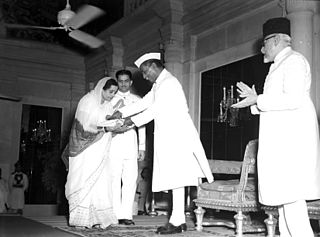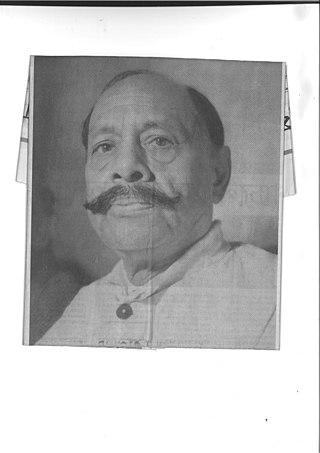Related Research Articles
In Hindustani music, a gharānā is a system of social organisation in the Indian subcontinent, linking musicians or dancers by lineage or apprenticeship, and more importantly by adherence to a particular musical style.

Kesarbai Kerkar was an Indian classical vocalist of the Jaipur-Atrauli gharana. A protege of Ustad Alladiya Khan (1855–1946), the founder of the gharana, from age sixteen, she went on to become one of the most noted khayal singers of the second half of the 20th century.
Alladiya Khan was an Indian Hindustani classical singer who founded the Jaipur-Atrauli gharana, also referred as just Jaipur Gharana. He is recognized for his revival, reinterpretation, and creations of many rare raags, compositions, and techniques and for producing disciples like Bhaskarbuwa Bakhale, Kesarbai Kerkar, and Mogubai Kurdikar.
Mogubai Kurdikar was a renowned Indian classical vocalist of the Jaipur-Atrauli gharana.
Atrauli is a town and a municipal board in Aligarh district in the state of Uttar Pradesh, India. Situated on the bank of the river Ganges, Atrauli is around 27 km (17 mi) from Aligarh and 52 km (32 mi) from Khair.

Ustad Faiyaz Khan was an Indian classical vocalist, an exponent of the Agra gharana of Hindustani classical music.
The Agra gharana is a tradition of Hindustani classical vocal music descended from the Nauhar Bani. So far, Nauhar Bani has been traced back to around 1300 AD, during the reign of Emperor Allauddin Khilji of Delhi.
The Jaipur-Atrauli Gharana is a Hindustani music apprenticeship fraternity (gharana), founded by Alladiya Khan in the late-19th century. Evolved from the dhrupad tradition, but known for khayal, this gharana is known for producing acclaimed musicians like Kishori Amonkar, Kesarbai Kerkar, Laxmibai Jadhav, Mogubai Kurdikar, Mallikarjun Mansur, Shruti Sadolikar, Dhondutai Kulkarni, Pandit Mrityunjaya Agadi Consequently, this gharana developed a reputation for its distinctive vocal aesthetics, raga repertoire, and technical aptitude.
Qutub Bakhsh, more commonly known as Tanras Khan, was an Indian musician of the Hindustani Classical tradition known for being a luminary of the Delhi Gharana.(House of Delhi classical musicians). He was a court musician and music teacher to the last Mughal emperor Bahadur Shah Zafar II.
Bhaskar Raghunath Bakhale was a Hindustani classical vocalist, a composer, and a teacher.

Ustad Badruddin "Manji" Khan (1888–1937) was a Hindustani Classical vocalist of the Jaipur-Atrauli Gharana founded by his father, Ustad Alladiya Khan. "He was called 'Manji' because he was his father's Manjhala (middle) son."
Srikrishna Haldankar, better known as Babanrao Haldankar, was an Indian classical singer, composer, and music teacher of Agra gharana of Hindustani classical music.
Sumati Mutatkar was an Indian classical music vocalist and musicologist from the Agra gharana of Hindustani classical music, and a Professor of Department of Music in University of Delhi.
Ramchandra Purushottam Marathe, also known as Pandit Ram Marathe, was a Marathi music director, singer, and actor on stage and in films. As a child actor, he performed the title role of Krishna in Prabhat Film Company's 1938 film, Gopal Krishna. He was disciple of Vilayat Hussain Khan, the maestro of Agra gharana of Hindustani classical music., Master Krishnarao Phulambrikar and others. Through Master krishnarao, he developed his Khayal style which had elements of different gharanas such as Jaipur, Gwalior and Agra.
Professor B. R. Deodhar was an Indian classical singer, musicologist and music educator. He was a vocalist of Khayal-genre of Hindustani classical music.
Sharafat Hussain Khan was an Indian classical vocalist from the Agra Gharana.
Nazir Khan, more commonly known as "Ghagge" Nazir Khan or Jodhpurwale Nazir Khan, was an Indian classical singer and, along with his elder brother Wahid Khan, founded the Mewati gharana, later popularized by Pandit Jasraj.
Vinayak Ramchandra Athavale, better known as V. R. Athavale or Vi. Ra. Athavale, was a Hindustani classical vocalist and one of the foremost Hindustani classical musicologists of the 20th Century, alongside Vamanrao Deshpande and Sharadchandra Arolkar. He composed using the pen name "Naad Piya". He is known for his critique of traditional ideas and modern aesthetics. He was trained primarily by Vinayakrao Patwardhan and Vilayat Hussain Khan and is considered a representative of Gwalior and Agra traditions.
Bhaiyya Ganpatra, alias "Sughar-piya", (1852–1920) was a member of the Gwalior royal family and known for pioneering the harmonium as an accompanying instrument. He was a member of the Gwalior gharana school of classical music.
The Khurja Gharana is a musical apprenticeship tribe of Hindustani classical music. Known for being Azmat Hussain Khan's and Jitendra Abhisheki's musical lineage, the gharana emerged from a family of Nauharbani musicians and gained recognition during the life of Altaf Hussain Khan who was born at Khurja.
References
- ↑ Sharma, Manorma (2006). Tradition of Hindustani music. New Delhi: A.P.H. Pub. Corp. p. 49. ISBN 81-7648-999-9.
- ↑ Kumāraprasāda Mukhopādhyāẏa (2006). The Lost World of Hindustani Music. Penguin Books India. pp. 154–. ISBN 978-0-14-306199-1. Archived from the original on 2024-05-02. Retrieved 2020-11-22.
- ↑ Manorma Sharma (2006). Tradition of Hindustani Music. APH Publishing. pp. 49–51. ISBN 978-81-7648-999-7. Archived from the original on 2024-05-02. Retrieved 2020-11-22.
- ↑ Jeffrey Michael Grimes (2008). The Geography of Hindustani Music: The Influence of Region and Regionalism on the North Indian Classical Tradition. pp. 142–. ISBN 978-1-109-00342-0.
- ↑ Ghosh, Tapasi (2008). Pran Piya: Ustad Vilayat Hussain Khan. India: Atlantic Publishers and Distributors. p. Appendix. ISBN 978-81-269-0855-4.